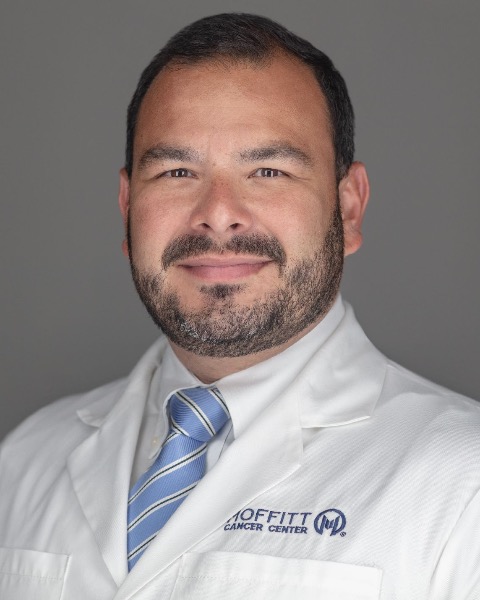Cellular and T cell engager Immunotherapy
Poster Session 1
P-012: Safety and Efficacy of Standard of Care (SOC) Teclistamab (TEC) in Patients with Relapsed/Refractory Multiple Myeloma (RRMM), a single center experience
Wednesday, September 27, 2023
1:30 PM - 2:30 PM EEST

Ariel Grajales-cruz, MD
Assistant Professor
H. Lee Moffitt Cancer Center & Research Institute, Tampa, FL, USA
Tampa, Florida, United States
Introduction: B- cell maturation antigen (BCMA) directed therapy and particularly bi-specific T cell engagers are a therapeutic option for patients (pts) with RRMM. MajesTEC-1 demonstrated an overall response rate (ORR) at 63%, progression free survival (PFS) of 11.3 months and duration of response (DOR) of 18.4 months. Adverse events were mainly low-grade cytokine release syndrome (CRS) (73%), cytopenias, and infections. TEC was FDA approved in October 2022 for RRMM.
Methods: We retrospectively evaluated outcomes of 28 pts treated with TEC as SOC at our institution from December 2022 to May 2023. CRS and ICANS were graded per ASTCT consensus, responses per IMWG. This retrospective study was IRB approved.
Results: All pts would have been ineligible for the MajesTEC-1 trial, due to prior BCMA directed therapy (n=22), cytopenias (n=8), renal impairment (n=5), and performance status (PS) (n=4). At the time of TEC, median age was 66 (range 48-81), and 7 pts (25%) had an ECOG PS ≥2. Thirteen pts (46%) had high risk cytogenetics (defined as del17, t(4;14), t(14;16)), and 15 pts (54%) had gain 1q; 10 (36%) were ultra-high risk (double and triple hit). Median prior lines of therapy (LOT) was 7 (4-15). Twenty-six pts (93%) were triple class refractory, and 12 (43%) were penta refractory. Twenty-two pts (79%) received prior BCMA directed therapy; CAR-T (n=16; 73%), Antibody Drug Conjugate (ADC) (n=2; 9%), or both CAR-T and ADC (n=4; 18%). Responses to prior BCMA directed therapies were as follows: 4 progression of disease (PD), 1 stable disease (SD), 1 minimal response (MR), 2 partial response (PR), 4 very good partial response (VGPR), 8 complete response (CR). Twelve (54%) pts received TEC right after progression from prior BCMA directed therapies. Twelve of thirteen pts (all receiving prior BCMA-directed therapy) tested for BCMA expression were positive by IHC, with 7 expressors responding. Twenty-five pts were evaluable for response at day 30. ORR was 52%, with 24% ≥VGPR and 12% ≥CR. ORR in pts with prior BCMA directed therapy was 44%, with 24% ≥VGPR and 12% ≥CR.
Grade 1 CRS was seen in 14 (50%) pts, grade 2 in 3 (11%) pts, and grade 3 in 2 (7%) pts. 6 pts received Tocilizumab for CRS; 2 for grade 1 CRS, 2 for grade 2, and 2 for grade 3. One pt received steroids for grade 3 CRS. Grade 3 ICANS was seen in 1 pt (4%), requiring steroids. Infections were seen in 12 (43%) pts, including viral, bacterial, and fungal. Five (18%) infections were deemed severe and required hospitalization. Prior to TEC, 14 (50%) pts had hypogammaglobulinemia (IgG < 400). After TEC, 8 pts (29%) developed new hypogammaglobulinemia. Eleven (39%) pts had treatment delays, mainly due to CRS and infections. Four pts died; 1 due to infection, and 3 due to progression of disease.
Conclusions: Pts treated with SOC TEC had a favorable ORR (52%) despite no pts meeting MajesTEC-1 trial eligibility criteria. No new safety signals were identified. Results will be updated with continued follow up.
Methods: We retrospectively evaluated outcomes of 28 pts treated with TEC as SOC at our institution from December 2022 to May 2023. CRS and ICANS were graded per ASTCT consensus, responses per IMWG. This retrospective study was IRB approved.
Results: All pts would have been ineligible for the MajesTEC-1 trial, due to prior BCMA directed therapy (n=22), cytopenias (n=8), renal impairment (n=5), and performance status (PS) (n=4). At the time of TEC, median age was 66 (range 48-81), and 7 pts (25%) had an ECOG PS ≥2. Thirteen pts (46%) had high risk cytogenetics (defined as del17, t(4;14), t(14;16)), and 15 pts (54%) had gain 1q; 10 (36%) were ultra-high risk (double and triple hit). Median prior lines of therapy (LOT) was 7 (4-15). Twenty-six pts (93%) were triple class refractory, and 12 (43%) were penta refractory. Twenty-two pts (79%) received prior BCMA directed therapy; CAR-T (n=16; 73%), Antibody Drug Conjugate (ADC) (n=2; 9%), or both CAR-T and ADC (n=4; 18%). Responses to prior BCMA directed therapies were as follows: 4 progression of disease (PD), 1 stable disease (SD), 1 minimal response (MR), 2 partial response (PR), 4 very good partial response (VGPR), 8 complete response (CR). Twelve (54%) pts received TEC right after progression from prior BCMA directed therapies. Twelve of thirteen pts (all receiving prior BCMA-directed therapy) tested for BCMA expression were positive by IHC, with 7 expressors responding. Twenty-five pts were evaluable for response at day 30. ORR was 52%, with 24% ≥VGPR and 12% ≥CR. ORR in pts with prior BCMA directed therapy was 44%, with 24% ≥VGPR and 12% ≥CR.
Grade 1 CRS was seen in 14 (50%) pts, grade 2 in 3 (11%) pts, and grade 3 in 2 (7%) pts. 6 pts received Tocilizumab for CRS; 2 for grade 1 CRS, 2 for grade 2, and 2 for grade 3. One pt received steroids for grade 3 CRS. Grade 3 ICANS was seen in 1 pt (4%), requiring steroids. Infections were seen in 12 (43%) pts, including viral, bacterial, and fungal. Five (18%) infections were deemed severe and required hospitalization. Prior to TEC, 14 (50%) pts had hypogammaglobulinemia (IgG < 400). After TEC, 8 pts (29%) developed new hypogammaglobulinemia. Eleven (39%) pts had treatment delays, mainly due to CRS and infections. Four pts died; 1 due to infection, and 3 due to progression of disease.
Conclusions: Pts treated with SOC TEC had a favorable ORR (52%) despite no pts meeting MajesTEC-1 trial eligibility criteria. No new safety signals were identified. Results will be updated with continued follow up.
